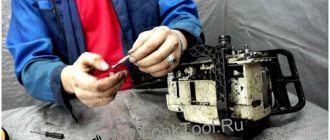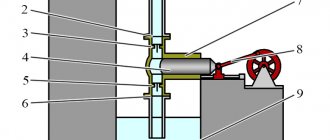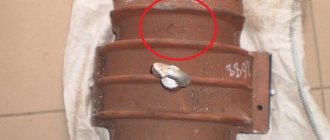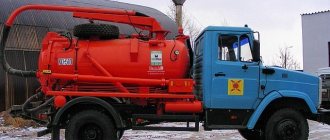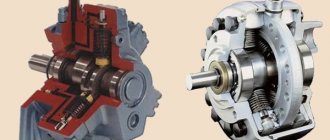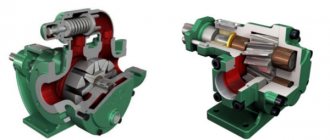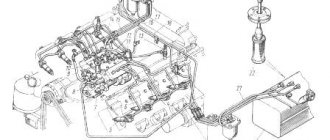The vacuum pump is designed to create a vacuum in the system. Using the volumetric or non-volumetric operation of the working mechanism, it can be used to create low, medium, high and ultra-high pressure. Today it is used in practically all areas of industry. The most actively used are rotary vane, diaphragm, liquid ring, diffusion, and turbomolecular vacuum pumps. Each type of pump is capable of performing specific functions. An ultra-high vacuum can only be created by using several types of pumps.
Navigation:
- Vacuum pump
- Checking the pump for vacuum
- Water ring vacuum pumps
- High vacuum pump
- Turbomolecular pump
Vacuum pumps are used in pressing equipment, heat treatment furnaces, woodworking plants, and other systems. They are capable of pumping out air and gases of various types at different speeds. It depends on the design features and materials used to create it. At the same time, to effectively pump out air without contaminating the mixture, diaphragm and dry rotary vane pumps are used, since they do not use vacuum oil.
Vacuum pump
Vacuum pumps are a tool for creating a vacuum, without which many processes would not be possible. Today, many operations involve the creation of a vacuum.
Vacuum pumps are used:
- for conducting laboratory research and physical experiments;
- during the study of elementary particles;
- for tests simulating space conditions;
- in metallurgical production;
- when spraying film;
- in the production of semiconductors;
- in mass spectrometry;
- in pressing equipment;
- when casting;
- vacuum forming;
- pharmaceuticals;
- Food Industry;
- vacuum packaging;
- and many other areas.
In all these areas, pumps with different operating principles and with different technical characteristics are used. Some installations produce rapid air pumping at low and medium vacuum, but are not capable of creating a low residual pressure.
To create a low vacuum, you can use a liquid ring, rotary vane, two-rotor, cam, scroll and diaphragm pump. The diaphragm pump has the lowest performance among all installations. It is usually used in laboratories to create low residual pressure with low pumping speed. At the same time, it has one undoubted advantage - the ability to work with aggressive gases, albeit at a low speed. In addition, it does not pollute the pumped out medium.
You can create a medium vacuum using some vane-vacuum, two-rotor, cam, and scroll pumps. All these installations can perform the function of a fore-vacuum pump, i.e. create a preliminary vacuum in the system for further use of the high-vacuum pump.
The most popular model of the above is the vane-rotor model, since it has high speed characteristics and can also create a higher residual pressure. At the same time, there are models that are designed for clean pumping of air or a gas mixture, which is carried out due to the absence of vacuum oil in the system.
High vacuum can be created using a turbomolecular, diffusion, cryogenic and steam-oil pump. They, in combination with fore-vacuum pumps, are capable of creating a deep vacuum. Most vacuum units, which are designed to create ultra-high pressure, do not have mechanically moving elements. The only pump that uses centrifugal drive force is the turbomolecular pump.
Scope of application of vacuum pumps
Vacuum is widely used in various technical devices. It allows you to reduce the boiling point for water or chemical liquids, remove gases from materials that require increased homogeneity of composition, and create sterile processing and storage conditions. With small dimensions and economical energy consumption, modern vacuum pumps allow you to quickly achieve a deep degree of vacuum. They are used in a wide variety of processes and fields of activity:
- in the oil refining and chemical industries to maintain the necessary conditions for reactions and separation of the resulting mixtures;
- when degassing metals and other materials to create parts with a uniform structure and absence of pores;
- in the pharmaceutical and textile industries for quick drying of products without increasing the temperature;
- in the food industry when packaging milk, juices, meat and fish products;
- in the process of vacuuming refrigeration and other equipment with increased requirements for the absence of moisture;
- for the normal functioning of automatic conveyor lines using vacuum suction cups as grippers;
- when equipping production and research laboratories;
- in medicine during the operation of breathing apparatus and dental offices;
- in printing for fixing thermal films.
Checking the pump for vacuum
A vacuum pump is a unit that operates under constant load. In order for it to perform its task smoothly, it is necessary to monitor its condition. The control elements in a vacuum pump are vacuum gauges and leak detectors. Using vacuum gauges, you can constantly monitor the pressure created by the pump, and leak detectors can find leaks in the system.
Depending on the principle of operation of the vacuum pump, membrane, classical, capacitive, thermistor, thermocouple, and insulating vacuum gauges can be used. The instrument includes a sensor that sends the received parameters to a vacuum gauge.
Classic vacuum gauges measure low pressure. As a rule, they contain a working fluid that expands when pressure changes under the influence of temperature. Liquid pressure gauges cannot be used without nitrogen traps, which release vapor that can harm the device.
Rotary Vane Oil Pump
Rotary Vane Oil Pump
When using a rotary vane oil pump, you need to remember the following nuances:
- The oil cools the parts and creates a seal. It leaves the reservoir through tubes, lubricating the surface of the stator and returning the required portions to the compression chamber. To prevent oil from entering the pumped flow, the system is additionally equipped with valves.
- To avoid oil loss, an oil trap is used for the vacuum pump. It also captures oil mist.
- During operation of the equipment, it is necessary to monitor that the oil readings in the inspection window do not exceed the permissible norm. If it changes color, you need to replace it. Draining is allowed when the unit is completely cooled to avoid burns.
- It is necessary to use the oil brands specified in the instructions, without mixing different types.
Before using an oil vane-rotor apparatus, you should check the equipment for compliance with the stated technical characteristics and GOST requirements.
Water ring vacuum pumps
Liquid ring vacuum pumps differ from other volumetric devices in that liquid is used in the working chamber when pumping out gases. As a rule, water is poured into the system, which performs several important functions. Firstly, it provides constant lubrication of moving parts. This assumes the absence of other lubricants, which means they can be used to perform clean pumping without contaminating the mixture. Secondly, it cools the system, so the pump does not overheat and can operate uninterruptedly for a long time. The installation is reliable and durable, therefore it is actively used in high-performance enterprises. Thirdly, when pumping contaminated mixtures, it cleans them. This occurs due to the special operating principle of the installation.
This occurs due to the special operating principle of the installation. Due to the action of centrifugal force, the water in the cells undergoes a circular or annular motion, which narrows more and more towards the outlet and causes the gas contained in it to narrow. The installation is popular in the chemical industry because of this feature.
More information about the features of the work
If you are interested in the principle of operation of a vacuum pump, then you should familiarize yourself with this topic in more detail. This process is not as easy as it might seem at first glance. It should begin with the fact that an analysis of the internal structure of such units that create a vacuum indicates that almost all devices of this type operate on the principle of displacement, which can be compared with the principle of operation of positive-displacement pumps. They are used to pump out decomposition products of various mixtures and water.
The vacuum created, or rather its magnitude, depends on the tightness of the space, which arises as a result of the operation of the pump mechanisms, among them the following should be highlighted:
- wheels;
- special plates;
- spools.
The principle of operation of a vacuum pump comes down to the fact that the unit must fulfill two conditions, the first of which is expressed in a decrease in pressure in a closed space, while the second is the fulfillment of the previous condition in a certain period of time. It is important that the sequence of conditions is maintained.
When the gas environment is absorbed by the equipment, and the pressure is not reduced to the required value, then the use of a forevacuum apparatus will be required. This, in turn, will reduce the pressure of the gas environment. This principle assumes the possibility of connecting pumps in series.
The operating principle of the vacuum pump should involve the use of vacuum oil, which eliminates gas leaks through the gaps of rubbing parts. Thanks to the use of oil, it is possible to seal and completely close the gaps. This oil acts as an excellent lubricant.
High vacuum pump
A high vacuum pump is a unit that is capable of creating a vacuum with a value of more than 10-3 mmHg. Most often, either a diffusion pump or a turbomolecular pump is used to perform this task. But at various enterprises there are steam-oil, getter, getter-ion, multi-charge, cryogenic installations. They all have different principles of operation, but together with a fore-vacuum pump they are capable of creating a high vacuum.
Cryogenic pumps are installations that can be used to perform clean, high-speed gas pumping. They are used in cryogenic systems where temperatures can reach extremely low temperatures. The units operate through the process of condensation and adsorption of the mixture on the surface, which is cooled to minimum values. The units are equipped with sets of panels used for different temperature ranges as refrigerant. A compressor is responsible for transferring helium, which performs the operation at high pressure and room temperature.
Making a vacuum seal with your own hands
A household pump can be made with your own hands in various ways and installations. The simplest design consists of parts that can be connected at home. In domestic conditions, vacuum installations can be used for packaging things, products, etc.
Components of a homemade vacuum pump:
- piston with drive;
- pen;
- drain tube;
- nut with washer;
- rubber seal;
- inlet valve
- flange type fitting.
Modification of various designs occurs using a bicycle or car pump, an aquarium supercharger, or an old refrigeration compressor.
Cuff Pump Conversion
Cuff designs are used in manual automotive pumping products. To manufacture the required device, you will need the mechanism itself, several tubes and a valve. The modification takes place in several steps; a homemade vacuum pump does not require the use of complex tools.
- The mechanism is disassembled; to do this, you need to unscrew the lock nut and remove the contents. Inside the product there is a cuff, a spring, locked with a washer and a nut, which need to be removed.
- Next, you need to turn the cuff to the opposite side; this solution is suitable for operations that do not require a powerful vacuum.
- The product is assembled in the reverse order, before installing the cuff, it can be lubricated with a small layer of grease, this will extend the service life and increase the softness of the ride.
- To maintain the vacuum, you will need a check valve. Its installation is carried out in a selected tube of a suitable size, to the base of the modification. Tightness is achieved by installing clamps on the connections; sealant is used during installation.
The finished product, subject to technical conditions, is capable of delivering an efficiency of up to 85%. It is enough to observe the parameters of tightness and the technical condition of the cuff.
Turbomolecular pump
The main application of a turbomolecular pump is the rapid creation of high and ultra-high vacuum in a sealed volume. It, unlike other installations that perform this task, has a volumetric operating principle. In addition, the turbomolecular unit is capable of independently maintaining the set pressure. This property is valued by companies that create aircraft parts.
The installations are used for research using high vacuum. A turbomolecular pump was created to replace the low-efficiency steam jet pump. It has a completely different design, but at the same time provides a higher pumping speed. The structure includes a shaft with disks, a housing, a rotor and an electric drive.
The creation of turbomolecular pumps is a complex and high-precision process. In production, only high-quality materials that can withstand high loads are used. Compression of gases occurs due to the presence of a large number of blades, which, rotating, draw them into the central part and push them to the outlet.
Main types of vacuum pumps
In the manufacture of devices for creating vacuum, metal and plastic materials are used that are resistant to the chemical effects of the pumped medium and have sufficient mechanical strength. Much attention is paid to the accuracy of the fitting of the units and the tightness of the contact of the surfaces, eliminating the reverse leakage of gases. Here is a list of the main types of vacuum pumps, differing in design and principle of operation.
Water ring
A liquid ring vacuum pump is one of the variants of liquid ring units, using the circulation of clean water to create a vacuum. It has the appearance of a cylinder with a rotor equipped with blades, rotating on an off-center shaft. Before starting work, it is filled with liquid.
When the engine starts, the impeller accelerates water along the inner walls of the housing. A crescent-shaped vacuum region is formed between it and the rotor. Gas flows into it from the pump inlet pipe. Moving blades move it along the shaft and throw it out through the outlet. Units of this type are often used for partial gas purification due to its intensive contact with water.
Using liquid as a working body provides many advantages.
- Water rotating in the space between the rotor and the pump body eliminates the possibility of backflow of gases, replacing seals and reducing the requirements for precision manufacturing of parts.
- All rotating parts of the pump are constantly flushed with liquid, which reduces friction and improves heat removal.
- Such devices rarely require repairs, have a long service life and consume minimal electricity.
- Working with gases containing drops of water and small mechanical impurities does not have a negative impact on the technical condition of the equipment.
The latter circumstance is important when using such pumps for pumping air from containers containing moisture. They are used for air conditioners and other refrigeration units when the system is evacuated before filling it with freon.
Vane rotor
Such pumps have a cylindrical body with a carefully polished inner surface and a rotor located inside it. Their axes do not coincide, so the side gap has different sizes. The rotor consists of special movable plates, which are pressed against the body by springs and divide the free space into sectors of variable volume. When the engine is turned on, the gases begin to move so that a vacuum is always created in the intake pipe, and excess pressure is always created in the pressure pipe.
To reduce friction, the plates are made of antifriction materials or special low-viscosity oils are used. Pumps of this type are capable of creating a fairly strong vacuum, but they are sensitive to the purity of the liquid or gas being pumped, require regular cleaning and contaminate the product with traces of lubricant.
Diaphragm-piston
The working body of pumps of this operating principle is a flexible membrane connected to a lever mechanism. It is made from modern composite materials that are resistant to mechanical loads. Its edges are firmly attached to the body, and the central part bends under the action of an electric or pneumatic drive, alternately reducing and increasing the space of the internal chamber.
The change in volume is accompanied by the suction and expulsion of incoming gases or liquids. When two membranes work together in antiphase, a continuous pumping mode is ensured. The valve system regulates the correct distribution and direction of flows. The mechanism does not have rotating or rubbing parts in contact with the pumped product.
The advantages of such pumps include:
- no contamination of the product with grease or mechanical impurities;
- complete tightness, eliminating leaks;
- high efficiency;
- ease of flow control;
- long-term operation in dry mode, which does not harm the structure;
- the ability to use a pneumatic drive for work in explosive environments.
Screw
The operating principle of screw pumps is based on the displacement of liquid or gas along a rotating screw. They consist of a drive, one or two helical-shaped rotors and a correspondingly shaped stator. High precision manufacturing of parts does not allow the pumped medium to slip back. As a result, excess pressure is formed at the pump outlet, and vacuum is formed at the inlet.
Due to the high requirements for manufacturing quality, such equipment is not cheap. It cannot be kept in “dry” mode for a long time.
The main advantages of such pumps:
- uniformity of flow;
- low noise level;
- ability to pump liquids with mechanical inclusions.
Vortex
Vortex vacuum pumps are similar in design to centrifugal equipment. They also have an impeller with blades that rotates on a central shaft. The fundamental difference is the location of the inlet pipe on the outer circumference of the housing, and not in the area of the central axis.
The minimum gap between the impeller and the housing ensures stable movement of the pumped liquid in the required direction. Units of this type are capable of creating a fairly high discharge pressure and have a self-priming effect. These pumps are easy to operate, easy to repair and have proven themselves in pumping gas-liquid mixtures, but they have low efficiency. They are sensitive to the ingress of mechanical impurities, which can lead to rapid wear of the impeller.

